Japanese Design Archive Survey
DESIGN ARCHIVE
Designers & Creators
Junichi Arai
Textile planner
Interview: 23 June 2022, 11:30-16:30
Venue: restaurant Basho, Kiryu City Civic Cultural Centre, Okawa Museum of Art
Interviewee: Riko Arai, Masanao Arai
Interviewer: Keiko Kubota, Yasuko Seki.
Author: Yasuko Seki
PROFILE
Profile
Junichi Arai
1932 Born in Kiryu City, Gunma Prefecture
1950 Graduated from Gunma Prefectural Kiryu High School
1955 Worked at Shinkin Textile Factory
1966 Established Ars Co.
1979 Established Antology Co.
1983 Awarded Special Prize at the 1st Mainichi Fashion Grand Prix.
1984 Opened NUNO in Roppongi, Tokyo.
1987 Awarded the title of Honorary Industrial Designer (Hon. RDI) by the Royal Society of Arts. Established Arai Creation System Ltd.
1992 Received the Design Medal from The Textile Institute.
2003 Awarded Honorary Doctorate from the University of London, UK
2011 Honorary Doctorate from the Royal College of Art
2014 Awarded the Commissioner for Cultural Affairs Prize
2017 Passed away
Other activities.
Teaching at Otsuka Textile Desing College, Tama Art University, Renmin University of China (Beijing), Tsinghua University (Beijing), Hong Kong Polytechnic University, etc.
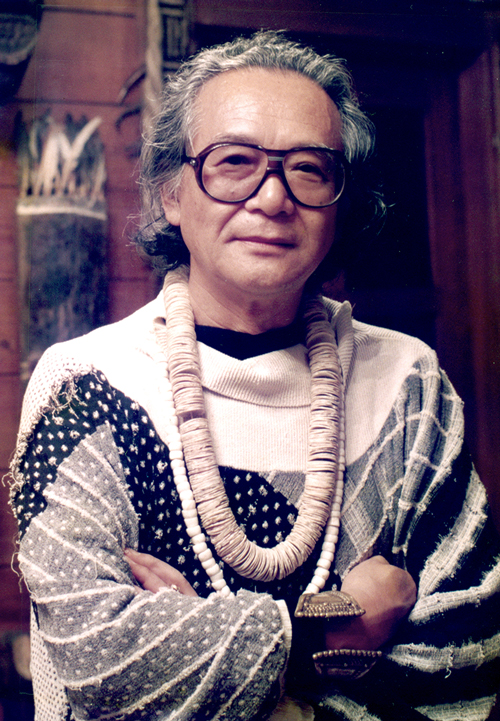
Description
Description
From two to three dimensions. Junichi Arai has fundamentally changed the dimension of cloth, and his influence on the textile and fashion design world is immeasurable. His way of life is defined by Arai's mottoes: 'Ten-i-muhou(to be natural and flawless)' and 'Juou-mujin(freely)'. True to his words, his inquisitiveness was directed towards the development of cloth-making with exploring threads and fabric prouction techniques. Another particularity is his position as a textile planner, not an artist, designer or artisan. He is not bound by production facilities or brands. Working with the most suitable technicians and producers, he invented and showed 'textiles' that had never been seen before. People call him 'Dream Weaver', 'Cloth Magician', 'Try-man', 'Worldman born in Kiryu' and so on.
Arai's textile production kept pace with the rapid growth of the Japanese economy and the globalisation of Japanese fashion and design: from the 1960s to the 1970s, Japanese designers such as Kenzo Takada, Issey Miyake, Kansai Yamamoto, Rei Kawakubo and Yohji Yamamoto caused a major stir in the Western-centric fashion world. Around the same time, Arai encountered a variety of fabrics from Asia, Central and South America and Africa, and in collaboration with Miyake, Yamamoto, Kawakubo and others, he breathed new life into the world of textiles.
The attitude of the Kiryu-born dream weaver remained unchanged throughout his life. He established his own centres of excellence - Ars, Anthologie and Arai Creation System - in accordance with the time of his career. The aim was to continue to explore the possibilities of cloth while building a working environment that suited the occasion.
Arai also made a significant contribution as a writer and educator. In each piece of cloth he weaves together layers of cutting-edge technology, beautiful poetry, knowledge of cloth and the seeds of nurturing people.
This time, we visited his wife and painter Riko Arai and son-in-law Masanao Arai, who supported Arai in his later years and now inherits his activities and works in the archives, while also being guided to places related to Arai. Most of Arai's valuable works and materials were lost in a fire in 2019. However, it is possible to look back on his great work through the works in museums around the world and the people who actually worked with him.
Masterpiece
Main work
Papilio (patent application filed in 1958/coat fabric for VAN in the USA/ exported 200,000 yards a year).
Miraclette (developed circa 1965/patented/aluminium dissolution textile printing technique)
Dragon-patterned shawl (manufactured circa 1979/opal finish)
Shrink-processed cloth "Korian Ginseng" (manufactured 1981/Shrunken tricot braided cord yarns and woollen fabrics)
Tie-dyed melt-off processed cloth (developed circa 1982)
Jacquard woven fabric “Cloth pattern”(manufactured circa 1983)
Jacquard woven fabric "Basket weave" (manufactured in 1982/double weave of cotton yarns and tricot braided cord yarns)
Spider-web patterned lace fabric (manufactured 1984/warp knitting by rushel machin)
Panel-patterned skirt fabric (manufactured circa 1982/woven with elastic yarn at the waist)
Metallised wool (developed 1990/International Wool Secretariat)
Crushed pleats (manufactured 1993/pleated on transfer-printed press)
Selected exhibitions.
“Contemporary Textiles", Cooper-Hewitt, National Design Museum, New York (1990); "Junichi Arai Textile Exhibition", The Museum of Decorative Arts, Toronto (1992); "Monochrome, exhibition by Junichi Arai & Riko Arai", University of California, Davis (1997); "The Fabric of Imagination: Junichi Arai and His Friends", Gangoji Temple, Nara (1998); "Contemporary Japanese Textile", The Museum of Modern Art, New York (1998); "Junichi Arai's Cloth", Harris Museum & Art Gallery, London (2002); "Junichi Arai: Evolving Cloth", the Museum of Modern Art, Gunma (2005); "Junichi Arai's Cloth: Fifty Years of Trajectories", Tsinghua University, Beijing (2010); “Tradition and Creation/Junichi Arai”, Tokyo Opera City Art Gallery and other venues (2013-14), “Cloth Re-creation: The Art of Junichi Arai”, Hubei Art Museum,Wuhan(2016-2017),“Self-organisation/Junichi Arai's Textile Anthology”, Hong Kong Polytechnic University (2017-2018),“The Work of Textile Planner Junichi Arai' Exhibition”, Okawa Museum of Art (2020).
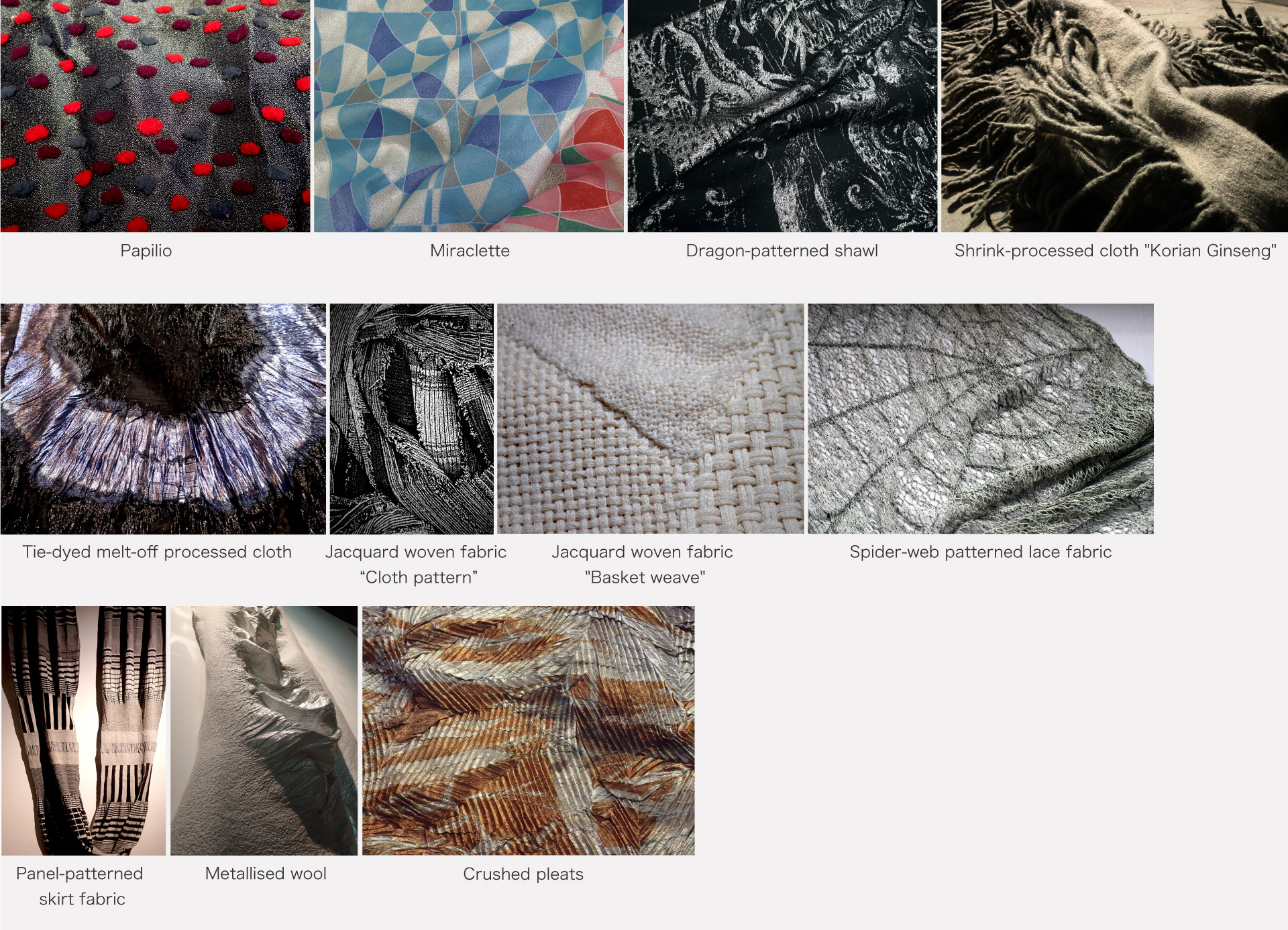
Interview
Interview
Arai’s textiles are a kind of invention, nowhere else in the world
Works and materials lost in the fire
ー We understand that Junichi Arai's artworks, fabric samples and materials were destroyed in a fire at his home in 2019. Despite this situation, we would like to talk to you about Mr Arai's archive.
Masanao The fire started in the evening of 14 May 2019 and continued to burn, finally extinguishing after midnight. Not only the artworks, but also fabric hanger samples, ethnic costumes collected from all over the world, development data and memos that he and his staff had written down, photographs and video records, scraps of newspapers and magazines that his mother-in-law Rico had compiled, and a huge collection of books were all burnt. The fire happened just as my wife (Junichi's eldest daughter) and I were gradually beginning to sort things out after the death of my father-in-law.
ー What was the cause?
Rico It was an electrical leakage. On the day of the fire, it was raining heavily with lightning strikes, and rainwater entered from the roof and leaked electricity from the wires, which ignited the fire.
Masanao I saw a pillar of fire in the room where the fire started and I tried to open the door to put it out, but I couldn't open it and I could barely get my mother-in-law out.
ー It was really tough. All of Arai's works and materials were destroyed by the fire?
Masanao In a stroke of bad luck, the Okawa Museum of Art acquired four major works in 2017, just before my father-in-law passed away, and 118 works in the following year, 2018. This donation was made possible by the support of Dr Hiroko Watanabe, Professor Emeritus of Tama Art University, Kiryu City, the Chamber of Commerce and Industry and everyone involved with the museum. However, as the museum is a public institution, a screening process was required for the donation. Therefore, the four major works were exhibited in the main hall of the Kiryu City Performing Arts Centre for people to see. However, that day my father-in-law became ill and was urgently hospitalised. At that time, he was already unwell and had to go to the hospital several times to have an intravenous drip.
Rico That night, Masanao came to his hospital room and reported to Arai that the screening had been highly successful. Perhaps relieved that one job was done, he died two days later.
ー The four works were chosen by Arai himself?
Masanao Yes, he went to the warehouse next to his house and selected them himself, even though he was not in good health. The four pieces are a huge curtain (a curtain-like work) that he made for an exhibition at the exhibition space of Harris Museum & Art Gallery in the UK.
ー What are the 118 works in the collection in 2018?
Masanao My father-in-law passed away in September 2017, but between 2016 and 2018, 118 works selected by himself travelled from the Hubei Art Museum in Wuhan to the Hong Kong University of Science and Technology. They came back to Japan and were collected by the Okawa Museum of Art. They were the ones that my father-in-law kept with him until the end.
ー It is a complete collection. What other objects are there?
Rico Ashikaga Museum of Art has masks from Africa and other regions collected by Arai.
Masanao Other museums in permanent collections include the Museum of Modern Art (NY), the Cooper-Hewitt, National Design Museum, the Art Institute of Chicago, the Victoria and Albert Museum, the Powerhouse Museum, the Hubei Art Museum and others in Europe, Australia and China.
ー I understand that Masanao is currently organising Arai's work and records?
Masanao I worked at the Gunma Textile Industry Research Institute from 1982 to 2014, providing technical support to local textile companies through product testing and development research. Through my work, I met my father-in-law and witnessed many different situations; since leaving the research institute, I have been working on the development of textiles and other products using metallic slit yarn, which I started with my father-in-law. Since his death, I and my wife have continued his production activities under the name 'Junichi Arai Memorial Studio', and are responsible for researching and studying his creative activities and achievements during his lifetime, handling interviews and exhibitions, and carrying out public relations activities.
ー It is regrettable that much of the studio was destroyed in the fire, but we hope that Arai's achievements will be passed on to future generations.
Exploration of cloth-making
ー We would like to ask you about Arai’s activities. How did he get involved in cloth making?
Rico He was born into a weaving family in Kiryu, heard the sound of looms, grew up wrapped in cloth and lived with the women weavers, so he naturally started making cloth. The path to getting there, however, was not a sequential one. War, disasters, rebellion against the family business, higher education and employment, encounters and partings with friends and predecessors, and many other experiences all led him to 'cloth'.
From the time he was born, Arai was expected by those around him to be his heir. He has loved reading since he was a child and used to devour books from the library when he was in primary school. He was also familiar with classical music under the influence of his parents. Growing up in such an environment, I think he accumulated a lot of knowledge and ideas. He also liked writing and was good at it. He wrote many essays and columns throughout his life.
Masanao My father-in-law gave up his university education after his family home was damaged by Typhoon Catherine (1947), and after participating in a puppet theatre and coterie of puppeteers, he entered the textile business in earnest. Then, in his 20s, he worked as an employee of his father's company, the Arakin Textile Factory. However, at the age of 34, Arai's father's company went bankrupt due to the failure of the textile printing technique 'Miraclet', which Arai developed himself. He then set up ‘Ars’. From then on, he outsources the production of his planned fabrics. Meanwhile, as a commissioned employee of Toray, he stayed in Mexico to provide technical guidance, which led him to Eastern Europe, South-East Asia and India. He encountered ethnic costumes from all over the world and was fascinated by the simple beauty of handmade fabrics.
In his 40s, his contacts led him to supply cloth to designers such as Kansai Yamamoto, BIGI, Issey Miyake and Rei Kawakubo. At the age of 47, he founded ‘Antologie’. Anthologie is a French word that translates as 'collection of lyrics' or 'collection of masterpieces', and seems to derive from the ancient Greek words for 'flower' and 'collection'. It is a beautiful word for collecting and composing songs and poems .......
He also stuck to his original title 'textile planner'. He did not have his own production facilities, but outsourced the production of his planned textiles to decentralised factories and craftsmen in the local and surrounding areas. He considers it important to join forces with his co-operators and therefore works as a 'textile planner'.
ー What are some of your most impressive fabrics?
Masanao There are so many, it is difficult to choose. Among them, I am most impressed by a skirt fabric with an elastic waist, which I developed in the 1980s. Highly elastic polyurethane threads are woven into the waist, and when the fabric is separated at the length of the skirt, it forms a trapezoidal shape. Two layers of the fabric are then sewn together at the sides to form a skirt. It was a revolutionary idea, and I think it also reflected the desire not to waste valuable fabric by cutting it off.
Rico Arai developed various techniques and fabrics and was granted nearly 40 patents, but only a few were utilised in business. He was not so much interested in making money, but was happy that his achievements would remain in the form of patents.
Masanao My father-in-law ran the companies Ars, Anthologie and Arai Creation Systems for textile production. However, his passion for creation was so great that he was unable to run the companies successfully and profitably. The aforementioned skirts were later mass-produced by imitators of the technique, but there was no return for my father-in-law.
ー What inspired Arai to come up with new fabrics? Was it, for example, because there was a new yarn or a new technique?
Rico Arai was often brought in with a new yarn and asked to try something. He was fortunate in his human connections. It is interdependent. For example, there is now a film and coating technology company, Oike (then Oike Shoten) in Kyoto . It used to be a gold thread manufacturer. Oike often came to Kiryu with sample threads and often collaborated with Arai. One of the most revolutionary products was a slit yarn made from thin film jointly developed by Toray and DuPont, which was plated with Oike's unique plating process and then split into thin strips. Using these yarns, it became possible to produce wide, shimmering textiles. There was talk of opening a museum in the headquarters of Oike to display these works of Arai.
Masanao I started to organise the works to be housed in that archive under the direction of my father-in-law. I used a microscope to observe and analyse each textile to record the techniques and skills used to compile Arai's achievements. However, all of these works were burnt in a fire. It was a great loss for Oike and for the textile industry.
ー Arai's achievements cannot be fully described. However, we can learn about his achievements through Akiko Moriyama's book ”Arai Junichi: Nuno/Kaleidoscope” and Masanao's article "Creation of cloth that wraps the soul: the work of Arai Junichi" (SPINNUTS, No. 106, 2020 JUNE).
Rico The magazine “Ginka” (No. 59, Autumn 1984, No. 63, Autumn 1985) is also well organised.
ー Rico, you are a painter, did you ever collaborate with Arai on fabric creation?
Rico Arai's ideas were so eccentric and inspired that I could not interfere. It was very difficult for others to get involved.
Masanao Though, there are fabrics that are based on drawings made by my mother-in-law. For example, a jacquard weave shawl of cotton high-twisted yarn, which was woven her picture of a gladiolas flower made for the magazine "Oul Yomimono(All Readings)", with scanning it into the conputer data of Jacquard weaving. Then there is the lace fabric with a spider's web pattern knitted by Russhel knitting machine.
ー I love the Spider's Web shawl.
Rico Thank you very much. The inspiration for the spider's web came from a sample given to me by Arai, which was woven like a fishing net. When I was developing my image, a waka poem by Asayasu Bunya from the Kokin Wakashu (compiled in the Heian period) came to mind, and I thought how wonderful it would be to weave a spider's web that sparkles in the water drops. Arai made the best use of an old knitting machine based on my original drawing to create a one-of-a-kind fabric. The spider's web shawl was made from cotton and silk yarns. The cotton one has a finish closer to my image. Unfortunately, that knitting machine is no longer available.
ー Does this mean that you can no longer make spider web shawls?
Rico Yes, because the craftsman who could use that knitting machine has passed away. Arai was not only chasing after newness, but also valued the traditional techniques, looms and knitting machines, especially in his home town of Kiryu, and the fabric production that made use of their characteristics. He struggled to change the reality that craftsmen and techniques were becoming obsolete.
Masanao My father-in-law also learnt a lot from his predecessors in the textile industry. First of all, he listened to what they taught him, and then he kept thinking about how he could change it to make use of it in his own work. What I find amazing about my father-in-law is that he started by making and twisting threads for his ideal cloth. Because he understood the properties of threads, he was able to freely combine threads to design new fabrics.
ー That is the essence of a textile planner.
Masanao My father-in-law is the one who created the unique title of textile planner. He was supposed to use all the technology available in Kiryu, not just the threads, and asked for help from other production areas for what he lacked. The variety of cloth he handled and the breadth of his knowledge were second to none for the wholesalers.
ー By the way, what does 'self-organisation' mean in his own words, Arai?
Masanao Wool shrinks (felts) when it is rubbed in wet conditions, and different processing methods produce different results, making it difficult to produce the same thing. There are laws of nature for this. For example, just as crystals have the power to form themselves, it is as if fabrics and yarns have the power to generate themselves.
The opening of the MISE(shop) of 'NUNO'.
ー Since the 1970s, Mr Arai is known for his collaboration with Kansai Yamamoto, Issey Miyake and Rei Kawakubo. As a weaver, the opening of his own shop, ’NUNO’, at the Roppongi AXIS was groundbreaking. (The shop is hereafter referred to as 'NUNO' to distinguish it from the textile Nuno.)
Rico Yes, the reason for the opening of 'NUNO' was also dramatic.
There is a company in Kiryu called Mitsuba, which manufactures automobile-related parts. Mr Hiroshi Ishibashi, then president of AXIS, and Mr Eiji Hayashi, then editor-in-chief of AXIS magazine, came to visit us there. Mr Ishibashi must have visited Mitsuba because he also worked for BRIDGESTON. There, Ishibashi asked Mitsuba's president's secretary if he knew anyone who was making interesting cloth in Kiryu. He was a junior student of Arai's at Kiryu High School and had a connection with the Student Art League, which I formed with volunteers when I was a student, so he introduced them to Anthologie. However, Anthologie was busy working in a small office and was not in a sutable space to welcome guests. We asked the two guests to sit on a small sitting that Arai had bought from the Philippines. Arai told his staff not to take over the phone while he was chatting with them. However, Yasuhiro Hamano called with an urgent matter. The topic was that Arai had been offered a special prize at the first Mainichi Fashion Grand Prix. Hamano was involved in the founding of AXIS and was the first editor-in-chief of AXIS magazine. Mr Ishibashi, Mr Hayashi and Arai were on the other end of that phone call. By such coincidence, Arai decided to set up shop at AXIS.
ー In the first issue of AXIS magazine, Hamano published a special feature on 'Eclecticism in Life'. The opening article was an interview with Gyoshin Koike (1906-82), owner of the western-style restaurant Basho. The very place we are interviewing right now is that 'Basho'. We would like to thank Rico and Masanao for your kindness.
Rico We heard that Mr Hamano had visited this restaurant several times at that time.
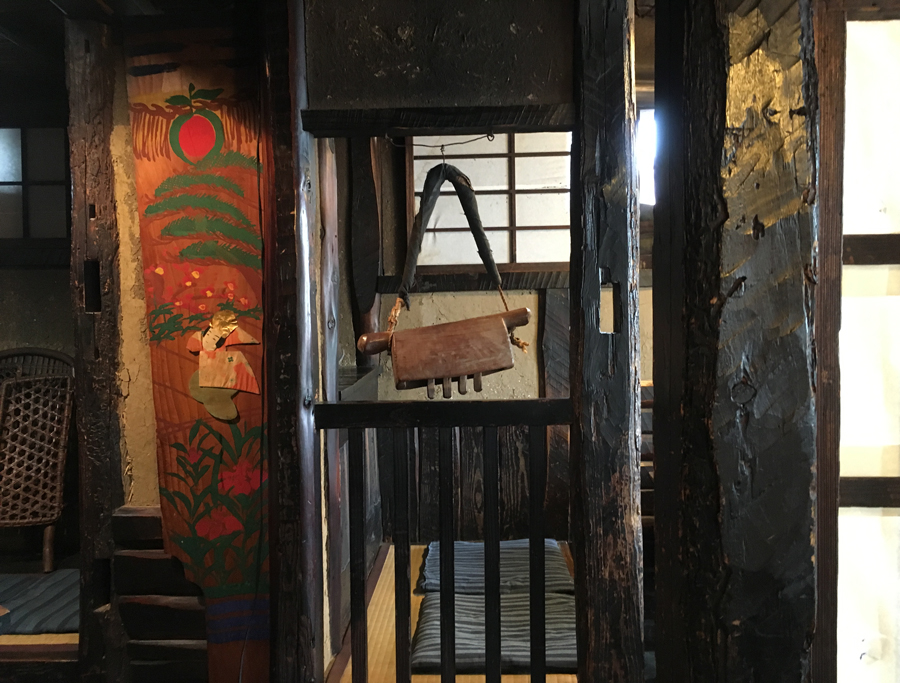
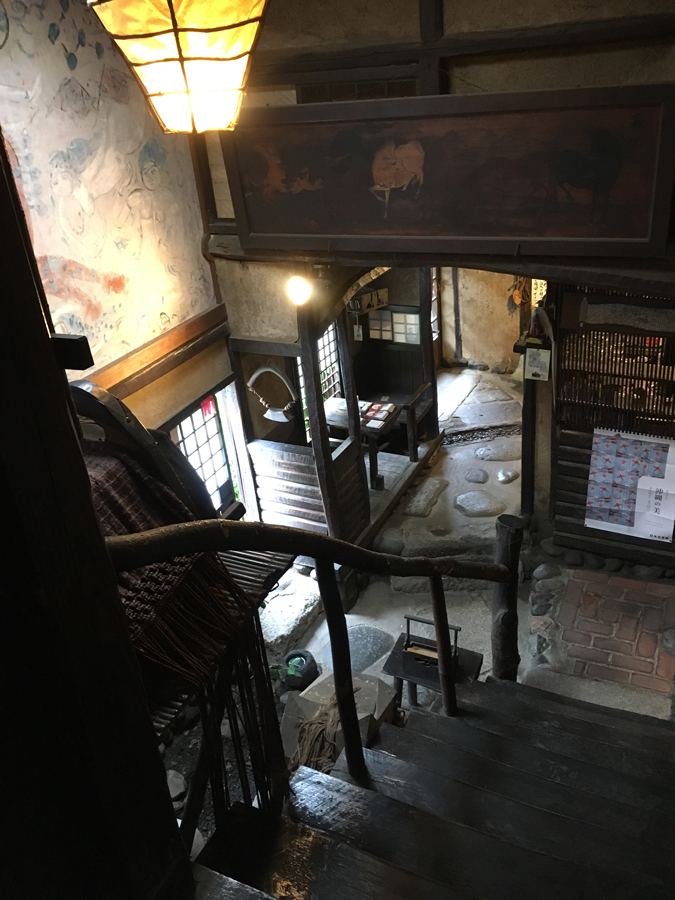
Restaurant Basho now, left wall is a mural by Shiko Munakata (photo right)
ー Arai was also greatly influenced by Gyoshin. In his collection of essays, 'Juou-mujin’, Arai writes: "Basho was established by turning his back on a world that was infested with makeshift culture. The furnishings and cuisine of this staged space, which transferred into the heart of Gyoshin, who was passionate about only the real thing, struck a chord with designers visiting Kiryu not only from Japan but from all over the world".
Rico Gyoshin used to be a cook at the former Burmese embassy. And he was also an expert in art, including architecture and fine arts, and collected folk art from all over the world. He was the person who asked that Shiko Munakata to paint a mural, but when it didn't look right, he plastered it over. The paintings were unearthed after Gyoshin's death. He had such a unique philosophy and aesthetic sense that he was adored by many people. Arai was a personal admirer of Gyoshin since his teenage years and was greatly influenced by him.
ー We are in that 'Basho' now, and I'm very emotional. Has Arai always wanted to own a shop like 'NUNO'?
Rico Arai has always wanted to deliver his cloth directly to customers, 'from manufacturer to user'. He believed that, like water, cloth can change shape and function in any way, so the user should be free to handle and wear the cloth. In other words, the manufacturer creates the cloth and the user makes it suitable for them. However, in the past, the distribution of cloth products depended on intermediaries such as wholesalers, which meant that the cloth could not be delivered directly from the manufacturer to the user.
ー In the video of the Tokyo Opera City Art Gallery, Mr Arai describes cloth as 'not solid, sometimes fluttering, changing with light, lying down, taking many different forms'. This is exactly the message that goes with 'from manufacturer to user'.
Rico He was also particular about the expression 'MISE' instead of shop. Arai himself decided on the name 'NUNO' and drew the logo "布" in chainese caractor for "NUNO" on dozens sheet of paper. He finally made the decision based on Hayashi's opinion, which is still used today in vigorous brushstrokes that protrude from the paper. The interior of the shop was also designed by him. The shelves, made of rough-hewn timber columns and thick single-ply boards, had an overwhelming presence. Rolls of new cloth were boldly displayed there. The shop also won the Commercial Space Display Design Award that year. 'NUNO' was the crystallisation of Arai's long-held dream.
ー What kind of fabric did Arai sell in 'NUNO' ?
Rico We sold mainly raw fabrics in white, natural cotton white, indigo and black, made of materials such as cotton, wool, linen and silk, as well as garments such as shawls and skirts. The 'NUNO' changed the concept of the traditional textile shop and attracted many customers from abroad.
Masanao The shop opened in April 1984. I happened to have kept my father-in-law's 1984 diary before the fire. It was filled with his actions, daily schedules and memos leading up to the opening of the 'NUNO'. It is a very important document and I had it displayed in the exhibition at the Okawa Museum of Art. Unfortunately, with the bankruptcy of Antologie in 1987, my father-in-law also left the management of 'NUNO' after only three years and a few months.
Diverse personalities
ー At the Kiryu Regional Centre for Local Industry Promotion, which you just showed us, we got to know another side of Arai.
Masanao Today you saw a Guatemalan folk costume, but that is part of a collection that was collected in the 1980s by volunteers including my father-in-law. The collection contains about 2,000 items from all over the world, including Japan, Asia, the Middle East, Africa, Europe and Latin America. These volunteers were very enthusiastic about developing the textile industry in Kiryu. The collection was gathered by them and acquired from collectors. They are one of the proud treasures of Kiryu. That exhibition room was also built at their instigation. Currently, this collection is shown three times a year at the World's Ethnic Costumes Exhibition.
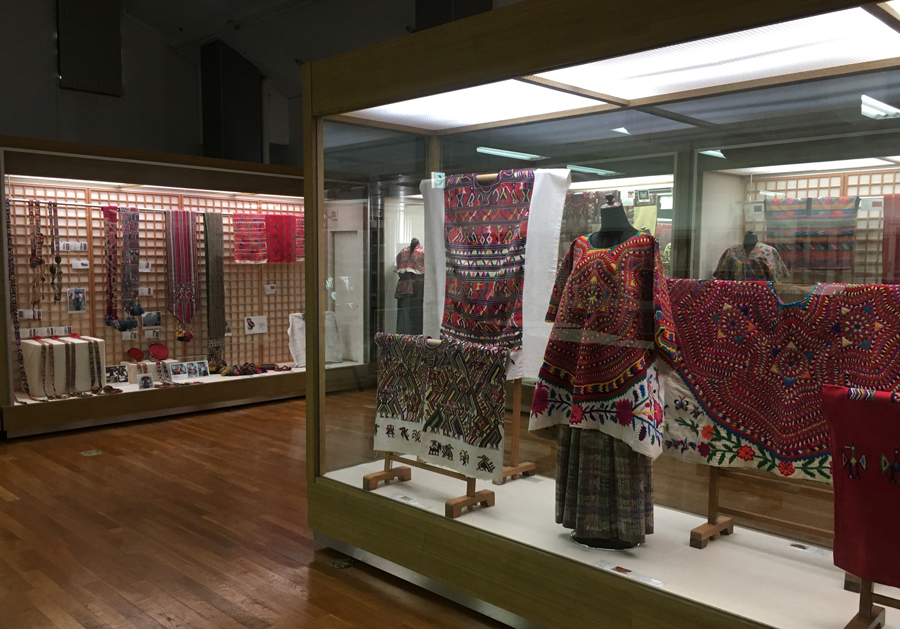
Guatemalan folk costume exhibition at the Kiryu Regional Centre for Local Industry Promotion .
ー The artworks on display in the Kiryu City Performing Art Centre adjacent to the centre were also produced by Arai, weren't they?
Masanao This cultural facility was opened in 1997. My father-in-law produced the thick stage curten for the main hall and three art works inside the building. For the thick stage curten production, he commissioned a design from Sheila Hicks, a textile artist living in Paris. The original rug "Flower Blooming Future" was completed by attaching dozens of plate-shaped pieces of cloth coloured by transfer printing to textiles woven at a weaving mill in Kiryu. The work in the main atrium was commissioned from British artist Peter Collinwood, and is a large work called 'STEELWEAVE1 [Macrogauze3D]', measuring 4 x 7.6 metres. At the time, BRIDGESTON's Utsunomiya plant had developed an ultra-fine stainless steel fibre with a thickness of 8 microns. My father-in-law was asked to develop an application for it, and immediately produced threads of it twisting with 3,600 satainless fibers. He commissioned Collin Wood to create a work of art using those threads. The work 'Request from the Future' on the wall of the entrance lobby is a similar tapestry woven with stainless steel threads. It was co-created by 17 female artists under Arai's supervision. The stainless steel threads of subtly different colours are woven together to create a heavy, shining effect. My father-in-law himself worked on ’Mineral’, a work inserted between the double glazing of the eight doors at the entrance to the Small Hall. The object is made by layering thin fabrics of slit threads (lame threads) made by aluminium vapour deposition on polyester film in an irregular shape, colouring them using a transfer printing machine and pressing them at the same time. With different colours and patterns on the front and back, it can be enjoyed from both sides.
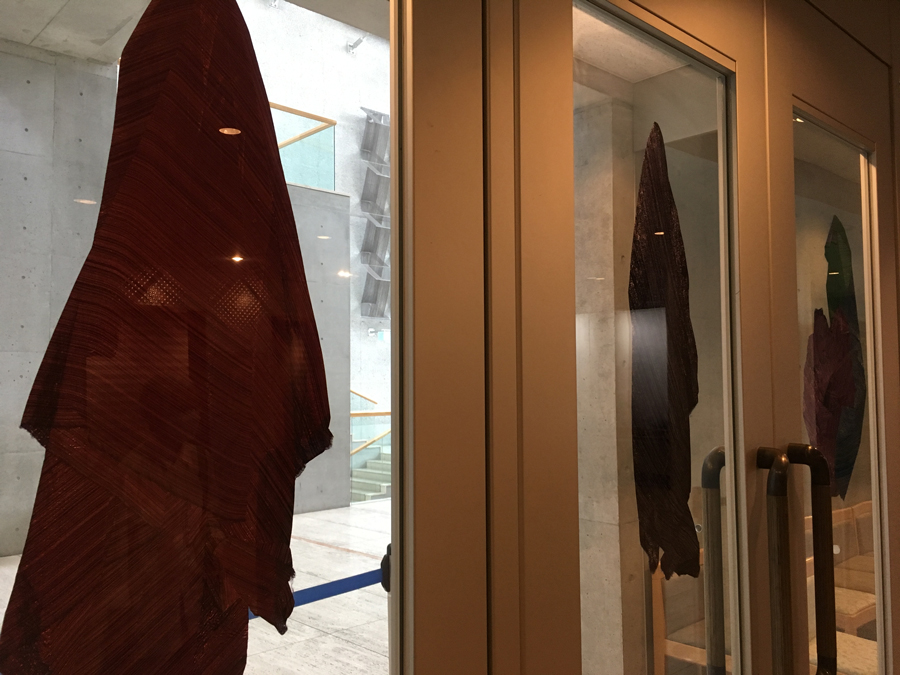
”Mineral”, an Arai work at the Kiryu City Performing Art Centre
ー It is a valuable work of Arai's that everyone can see. In 2020, the Okawa Museum of Art held the 'Textile Planner, Junichi Arai's Work' exhibition, which attracted many visitors despite the Corona disaster, didn't it?
Masanao The exhibition featured works from the 1980s to the end of his life, including pieces he made for Issey Miyake and Rei Kawakubo, the shiny fabric that was used as a costume for Tokiko Kato, and other items that belonged to his father-in-law. He was a close friend of the late Eiji Okawa, founder of the museum, and as a result, I am glad that his works are housed in the museum in my home town of Kiryu.
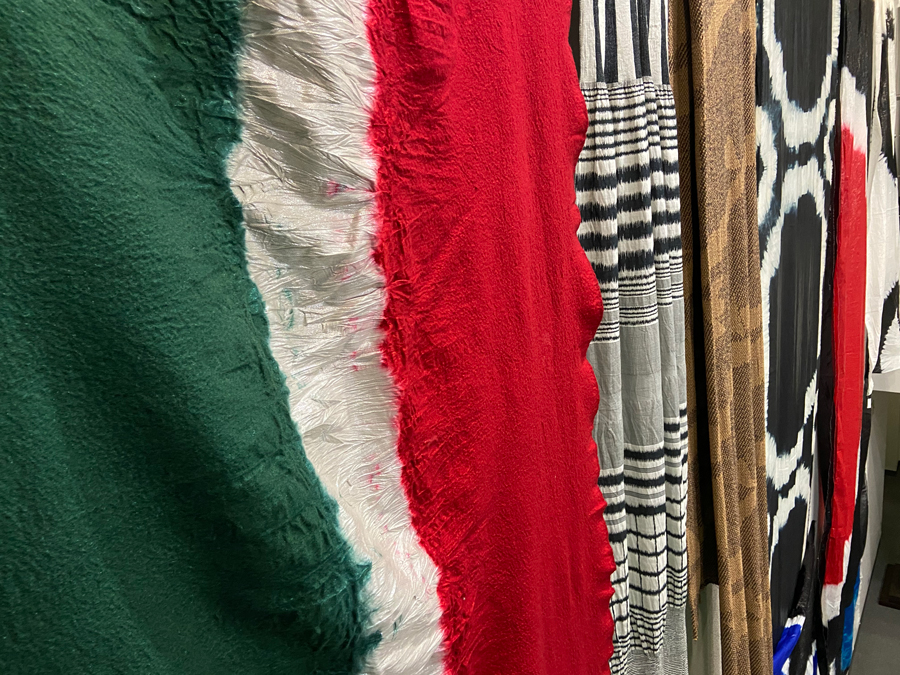
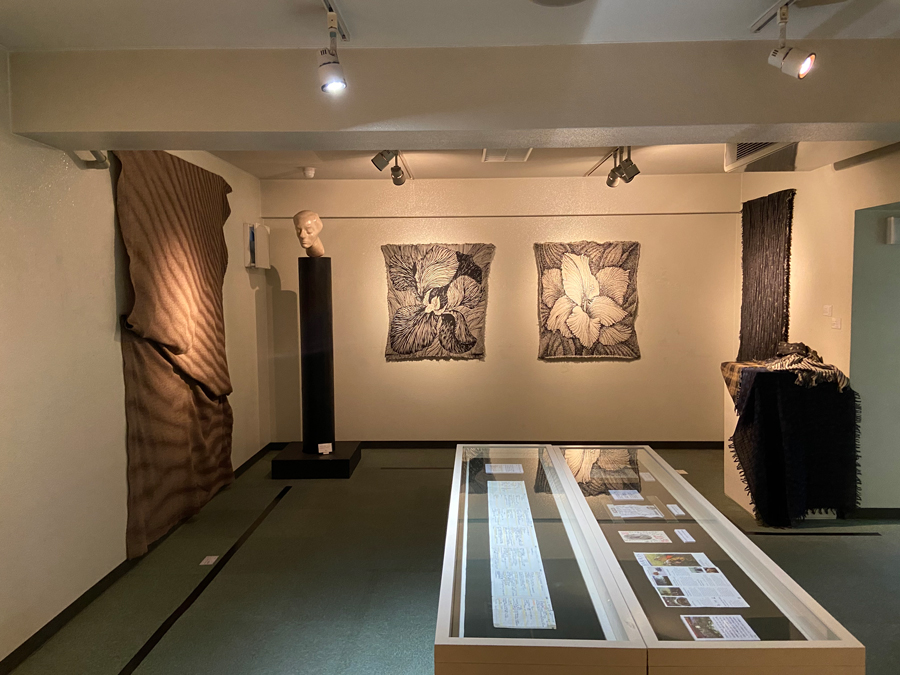
View of the venue of the 'Work of Junichi Arai' exhibition at the Okawa Museum of Art. The original gladiolus artwork at the back of the photo is a drawing by Rico (photo right). © Okawa Museum of Art
ー Arai also wrote columns and essays.
Masanao I remember Arai writing manuscripts in the early hours of the morning at the hotel where we were travelling, or on the express train Ryomou between Asakusa and Shin Kiryu. The first was a series of 33 columns in the Tokyo Times in 1980-81, 'Seeing, Hearing and Trying'. The friendship between Tokiko Kato and he (Junichi) began when she took an interest in the article 'Love at First Hearing'. Arai then began to provide her with fabric for her costumes. Other articles include 'Ten-i-muhou', which ran 148 times in 'WWD Japan' from 1988 to 1996, and 'Juou-mujin', which ran 50 times in the local 'Kiryu Times' for about two years from 1994. He was keen to convey his thoughts in written form and wrote many letters.
ー Mr Arai was exactly as the title of his column says: ‘Ten-i muhou’ and ‘Juou-mujin’. He was also called by many other titles, such as 'cloth wizard', 'dream weaver' and 'textile futurist'. Akiko Minosaki, in the introduction to Arai's essays, 'Juou-mujin', wrote: 'He travelled all over the world, meeting and talking with people in search of cloth that had not yet been seen. He always returned to his home town of Kiryu, a traditional textile production area. He kept his creative hand moving, and was known as a 'textile planner'.
Masanao My father-in-law's work can be described as a kind of invention. Moreover, it covered many different dyeing and weaving techniques. I don't think there is work like this anywhere in the world.
ー Experimentation and invention, discovery and creation. Mr Arai has renewed the existing image of textiles. Thank you very much for showing us around the places associated with Arai and for your valuable talk.
Enquiry:
NPO Platform for Architectural Thinking
https://npo-plat.org

